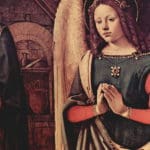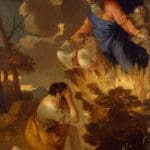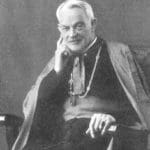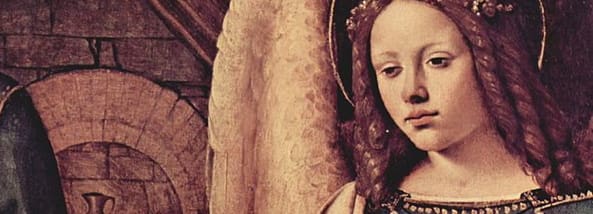FORESHADOWINGS OF MARY
“Whence is this to me that the mother of my Lord should come to me?”
Luke 1:43
1. Though so little is said of Our Lady in the Gospels, there is abundant evidence both there and elsewhere to show that she too was part of the Expectation of the Jews along with her Son;  and reason confirms that the two could scarcely have been separated. When the Angel appeared to her, to announce the Incarnation, he speaks as to one who was accustomed to meditate on ancient prophecies; and six months later she breaks out in words that could only have come from one who recognized in herself the fulfillment of many things foretold. Elizabeth’s words, again, disclose one who appreciated to the full the meaning of Mary’s motherhood; and Simon later is even more explicit. Lastly, the tradition of the second Eve was one which the Jews held dear.
and reason confirms that the two could scarcely have been separated. When the Angel appeared to her, to announce the Incarnation, he speaks as to one who was accustomed to meditate on ancient prophecies; and six months later she breaks out in words that could only have come from one who recognized in herself the fulfillment of many things foretold. Elizabeth’s words, again, disclose one who appreciated to the full the meaning of Mary’s motherhood; and Simon later is even more explicit. Lastly, the tradition of the second Eve was one which the Jews held dear.
2. In the same way, then, as the great men of the Old Testament prefigure the Son, so did the great women prefigure the Mother; and it is to be noticed that the history of the Jews is studded with the names of great women far more than is the history of any other ancient people. Rebecca secured the inheritance for her son Jacob. The mother of Moses saved him from the waters to be the saviour of his people. Hannah breaks into her song of praise at the knowledge that she is to be a mother, which song is the background for the greater song of Mary herself. Deborah and Jael, each in their turn, are the saviours of their people; later come the names of Judith and Esther, each reminding the Jews of that “first prophecy: I will set enmities between thee and the woman, and between thy seed and her seed; it shall crush thy head”; and telling them that in the future the Mother of Him that was to come would have her share in the work of Redemption.
3. Again, there were the countless other types, of which the Church has made so much use in her prayers and liturgy. The Little Office of her Immaculate Conception is full of them. She is the Gate of Heaven, the ladder of Jacob, by which God came among men. She is the Burning  Bush, seen by Moses, the “holy ground” in which God dwelt; as the Church sings on the feast of the Circumcision: “Rubum quern viderat Moyses incombustum, conservatam agnovimus tuam laudabilem virginitatem.” (“In the bush which Moses saw burning but never burnt we recognize thy glorious virginity preserved.”) She is the Ark of the Covenant, in which the Sacred Bread from heaven was preserved. She is the Tower of David, in which the King took up His abode. She is the Golden Temple, hallowed by the Presence of Jehovah. If we would lengthen out the list, we have but to look at the writings of many of the Fathers, of those especially on whom, as it were, the glorious sunrise of Our Lady’s honor shone after the first centuries of the dawning.
Bush, seen by Moses, the “holy ground” in which God dwelt; as the Church sings on the feast of the Circumcision: “Rubum quern viderat Moyses incombustum, conservatam agnovimus tuam laudabilem virginitatem.” (“In the bush which Moses saw burning but never burnt we recognize thy glorious virginity preserved.”) She is the Ark of the Covenant, in which the Sacred Bread from heaven was preserved. She is the Tower of David, in which the King took up His abode. She is the Golden Temple, hallowed by the Presence of Jehovah. If we would lengthen out the list, we have but to look at the writings of many of the Fathers, of those especially on whom, as it were, the glorious sunrise of Our Lady’s honor shone after the first centuries of the dawning.
Summary Meditation Points:
1. The Church sanctions, and the Gospels more than justify, the searching for anticipations of Our Lady, as of her Son, in the persons and events of the Old Testament.
2. Thus in the line of great women she is foreshadowed; beginning with the thought that she is to be a second Eve, reversing the work done by the first.
3. In many types, too, she is prefigured, making it easy for saints and fathers of the Church to prolong her praises in their prayers and writings; a practice which was common among them.
 Editor’s Note: This meditation is from Archbishop Alban Goodier’s “The Prince of Peace” (1913).
Editor’s Note: This meditation is from Archbishop Alban Goodier’s “The Prince of Peace” (1913).
Art: Detail from “The Adoration of the Child” by Piero di Cosimo, ca 1500; Burning Bush, Sébastien Bourdon, 17th century; both PD-US, Wikimedia Commons. Mirror of Archbishop Alban Goodier, S.J., www.stmaryscadoganstreet.co.uk, all rights reserved, used with permission.




